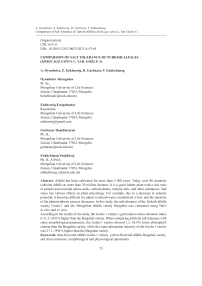Comparition of salt tolerance of turkish alfalfa (Medicago sativa L. var. Gozlu-1)
Автор: Oyunbolor A., Enkhzorig Z., Gurbazar D., Enkhchimeg V.
Журнал: Природа Внутренней Азии @nature-inner-asia
Рубрика: Биология
Статья в выпуске: 4 (26), 2023 года.
Бесплатный доступ
Alfalfa has been cultivated for more than 3 000 years. Today, over 80 countries cultivate alfalfa on more than 30 million hectares. It is a good fodder plant with a rich ratio of protein and essential amino acids, carbohydrates, mineral salts, and other substances. Salt stress has various effects on plant physiology. For example, due to a decrease in osmotic potential, it becomes difficult for plants to absorb water, metabolism is lost, and the intensity of the photosynthesis process decreases. In this study, the salt tolerance of the Turkish alfalfa variety Gozlu-1 and the Mongolian alfalfa variety Burgaltai was compared using NaCl in vitro and ex vitro. According to the results of the study, the Gozlu-1 variety’s germination stress tolerance index is 11.2-39.0 % higher than the Burgaltai variety. When comparing artificial salt tolerance with some morphological parameters, the Gozlu-1 variety showed 1.2-18.4 % lower chlorophyll content than the Burgaltai variety, while the water absorption intensity of the Gozlu-1 variety was 27.1-39.8 % higher than the Burgaltai variety.
Blue-flowered alfalfa gozlu-1 variety, yellow-flowered alfalfa burgaltai variety, salt stress tolerance, morphological and physiological parameters
Короткий адрес: https://sciup.org/148328098
IDR: 148328098 | УДК: 633.31 | DOI: 10.18101/2542-0623-2023-4-53-65
Текст научной статьи Comparition of salt tolerance of turkish alfalfa (Medicago sativa L. var. Gozlu-1)
Among environmental stresses for plants, factors such as drought, heat, cold, soil salinity, and fertility degradation (nitrogen deficiency) significantly reduce plant yield. Soil salinity evolves rapidly depending on environmental factors such as temperature and precipitation, as well as agricultural practices and technologies [Castroluna et al., 2014]. About 1.7 % of soil in Mongolian territory has high salinity, mainly distributed in lowlands such as the bottom of large and small hollows, near brackish lakes, river floodplains, and lakes with no outflow [Batchuluun, Gerelbaatar, 2015]. Global warming, decreased rainfall, and increased livestock numbers increase pasture degradation. In forest and steppe areas, the main sites of pasture resources, there is a risk of more intense degradation. Therefore, it is necessary to introduce the use of pastures that have not lost their primary state to support the recovery of perennial plants in degraded pastures, reduce the growth of inedible plants, and quickly reduce soil erosion [Swiss Agency for Development and Cooperation, 2015]. There is a need to increase fodder production and grow cultivated fodder to replace natural fodder, given the need to reduce the effects of force majeure and possible risks related to global warming and climate change, and to improve livestock productivity [Ministry of Food, Agriculture and Light Industry, 2022].
Alfalfa is a perennial crop that can be used in natural pastures to restore degraded pastures and crop fields with poor fertility. There is a need to increase fodder production and grow a cultivated fodder to replace natural fodder in view of the need to reduce the effects of force majeure and possible risks related to global warming and climate change, and to improve the productivity of livestock. Alfalfa as a fodder plant is a perennial crop that can be used in natural pastures to restore degraded pastures and crop fields with poor fertility. Therefore, our main objective of this study was to compare salt tolerance of Gozlu-1 variety (Turkish blue-flowered alfalfa) with Burgaltai (only one introduced variety of Mongolia) in in vitro and ex vitro conditions. Based on the results of this study, it is important to determine whether Turkish Gozlu-1 alfalfa can be cultivated under irrigated conditions or in saline soils.
Materials and methods
Plant materials
Gozlu-1 Turkish blue-flowered alfalfa and Burgaltai Mongolian yellow-flowered alfalfa seeds were used as plant materials.
Determination of the effect of salt on the stress resistance index of seed germination
The alfalfa cultivar seeds were sterilized, and 20 seeds were placed in Petri dishes with filter paper. The following formula was used according to the methodology of Raza et al. (2021) to evaluate the effect of salt on the seed germination index by measuring effects on the second, fourth, sixth, and eighth days after the start of the experiment by irrigating with 10 ml of different salt solution concentrations every day:
Salt-affected seed germination = nd2 (1.00) + nd4 (0.75) + nd6 (0.50) + nd8 (0.25), nd — the day of seed germination
The seed germination salt resistance index was calculated by the following formula:
Seed germination index (%) = (salt-affected seed germination) / (controlled seed germination) × 100
Determination of the effect of salt on the stress resistance index of shoot and root length of alfalfa varieties
Alfalfa plants were grown for 30 days and then watered until saturation with different salt concentration solutions (0–250 mM). Phenological observations of plants were made daily, and when phenotypic differences occurred, the shoot and root length stress resistance index was calculated by using the following formula according to the methodology of Raza et al. (2021). The experiment was performed with three replications:
Shoot length stress resistance index (%) = (salt-affected plant shoot length) / (shoot length of control plants) × 100
Root length stress resistance index (%) = (root length of salt-affected plants) / (root length of control plants) × 100
Determination of the effect of salt on the dry weight index of plant leaves
The leaves of the salt-stressed and control plants were cut and dried at 70 °C for 24 hours, and the dry weight was determined by weighing [Raza et al., 2021]:
Leaf dry weight index (%) = (salt-affected leaf weight) / (control leaf weight) × 100
Estimation of chlorophyll content
The concentrations of chlorophyll a, chlorophyll b, and total chlorophyll were calculated using the following equation:
Chlorophyll a: 12.7(A663) – 2.69(A645)
Chlorophyll b: 22.9(A645) – 4.68(A663)
Total Chlorophyll: 20.2(A645) + 8.02(A663)
The chlorophyll content of the Gozlu-1 and Burgaltai leaves exposed to drought under laboratory conditions was compared with a spectrophotometer.
Method of measuring leaf water uptake intensity
Water was withheld for seven days after six weeks of germination. In the morning, the second fully expanded leaves were taken from each variety and weighed immediately. They were kept for one night at room temperature in a test tube containing 10 ml of distilled water. The water was removed from the leaves’ surfaces, and the leaves were weighed again to obtain their turgid weight (saturated weight) [Raza et al., 2021]:
Leaf water uptake intensity (%) = Saturated weight – Fresh weight x 100 / Saturated weight
Data analysis
Each experiment was performed with three replications of the mean values, and the standard deviation was calculated using Microsoft Excel.
Results
Effect of salt on the stress tolerance index of seed germination
Increasing the osmotic pressure with salt solutions of different concentrations has a negative effect on plant growth and seed germination by limiting water absorption.
When determining the index of seed germination, compared to the control, the Burgaltai variety decreased by 28.6 % at 50 mM, by 42.8 % at 100 mM, and by 94.7 % at 150 mM; seed germination completely stopped at 200 mM. The Gozlu-1 seed germination stress resistance index decreased by 13.8 % compared to the control at 50 mM, 30.9 % at 100 mM, and 55.0 % at 150 mM; seed germination completely stopped at 200 mM. The Gozlu-1 germination stress tolerance index was 14.8 % higher at 50 mM, 11.2 % higher at 100 mM, and 39.0 % higher at 150 mM than the Burgaltai variety (Table 1, Fig. 1).
Table 1
Seed germination index of alfalfa plants in various concentrations of salt, %
|
Alfalfa varieties |
NaCl concentration, mМ |
|||||
|
0 |
50 |
100 |
150 |
200 |
250 |
|
|
Gozlu-1 |
95.7±0.6 |
81.9±0.2 |
64.8±0.4 |
40.7±0.5 |
0 |
0 |
|
Burgaltai |
96.4±0.4 |
67.8±0.1 |
53.6±0.2 |
31.7±0.3 |
0 |
0 |
Means of three replicates ± SD after 15 days of salt stress testing

Fig. 1. Seed germination of alfalfa cultivars treated with different salt concentrations after 14 days (A: Gozlu-1, B: Burgaltai; from left to right: NaCl concentrations of 0, 50, 100, 150, 200, and 250 mM)
Effect of salt on the stress resistance index of shoot and root length
Shoot length
When the alfalfa varieties were stressed by irrigation with 50, 100, 150, 200, and 250 mM NaCl solutions, the shoot length of the Burgaltai variety decreased by 3.9 cm (70.0 %) at 50 mM, 5.8 cm (74 %) at 100 mM, 5.9 cm (78.0 %) at 150 mM, and 6.9 cm (98 %) at 200 mM compared to control plants, and shoot growth completely stopped at 250 mM (Figure 2). The shoot length of the Gozlu-1 variety decreased by 1.9 cm (24.3 %) at 50 mM, 2.2 cm (28.6 %) at 100 mM, 2.8 cm (35.5 %) at 150 mM, 3.6 cm (45.4 %) at 200 mM, and 5.4 cm (67.8 %) at 250 mM compared to control plants (Fig. 2, 4). Based on these results, we concluded that the shoot length of the Gozlu-1 variety was 45.7 % higher than the Burgaltai variety at 50 mM, 45.4% at 100 mM, 42.5 % at 150 mM, 52.6 % at 200 mM, and 32.2 % at 250 mM.
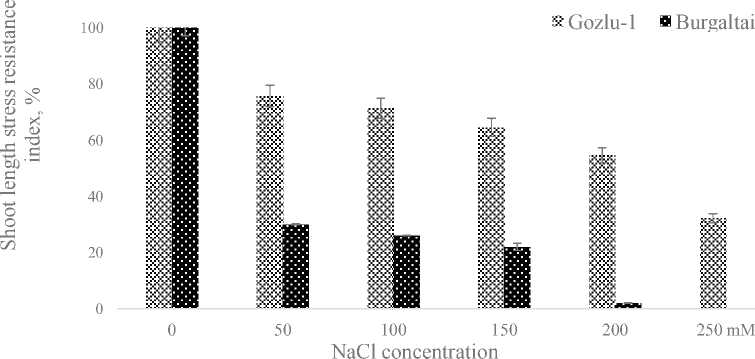
Fig. 2. Shoot length index of alfalfa varieties affected by salt, %. Columns indicate the mean and error; bars indicate the standard deviation of three replications
Root length
When the alfalfa varieties were stressed by irrigation with 50, 100, 150, 200, and 250 mM NaCl solutions, the root length of the Burgaltai variety decreased by 1.6 cm (18.8 %) at 50 mM, 2.8 cm (32.0 %) at 100 mM, 3.4 cm (38.0 %) at 150 mM, 7.7 cm (86.3 %) at 200 mM, and 8.1 cm (90 %) at 250 mM compared to control plants (Fig. 3). Whereas, in Gozlu-1 variety, it was 0.6 cm (7.3 %) at 50 mM, 2 cm (22.5 %) at 100 mM, 2.2 cm (25.0 %) at 150 mM, and 200 mM longer than that of control plants, decreased by 4.8 cm (53.8 %), and at 250 mM, the root growth was shorter by 6.3 cm or 70.0 %. These results show that the root length of the Gozlu-1 variety was 7.5 % longer than the Burgaltai variety at 50 mM, 9.5 % at 100 mM, 13.0 % at 150 mM, 32.5 % at 200 mM, and 20.0 at 250 mM (Fig. 3, 4).

Fig. 3. Root length index of alfalfa varieties treated with different salt concentrations. Columns indicate the mean and error; bars indicate the standard deviation of three replications
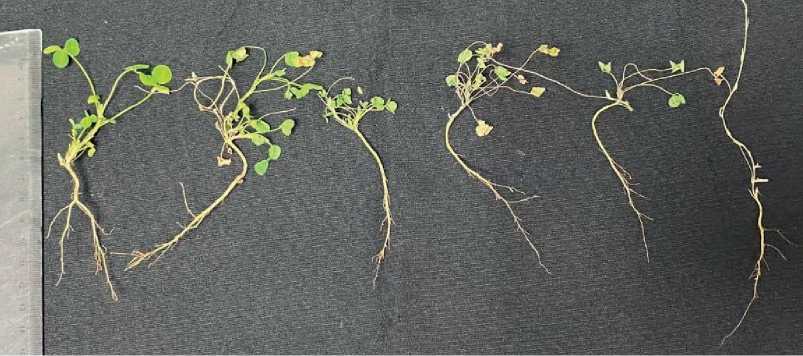
Fig. 4. Phenotype of the Gozlu-1 variety treated with different salt concentrations after 30 days. From left to right: NaCl concentrations of 0, 50, 100, 150, 200, and 250 mM
Effect of salt on the shoot and root stress resistance index
Shoot weight
The shoot weight index of the Burgaltai variety stressed by watering with different salt concentrations decreased by 0.11 g (58.2 %) higherat 50 mM, 0.157 g (83.0 %) at 100 mM, 0.174 g (92.0 %) at 150 mM, 0.183 g (96.8 %) at 200 mM compared to control plants, and shoot growth stopped completely at 250 mM. The shoot weight index of the Gozlu-1 variety stressed by watering with different salt concentrations decreased by 0.095 g (48.9 %) at 50 mM, 0.156 g (80.4 %) at 100 mM, 0.16 g (82.4 %) at 150 mM, 0.17 g (87.6 %) at 200 mM, and 0.184 g (94.8 %) at 250 mM compared to control plants (Fig. 5).
The shoot weight of Gozlu-1 was 9.3 % higher than the Burgaltai variety at 50 mM, 2.6 % at 100 mM, 9.6 % at 150 mM, 9.2 % at 200 mM, and 4.6 % at 250 mM.
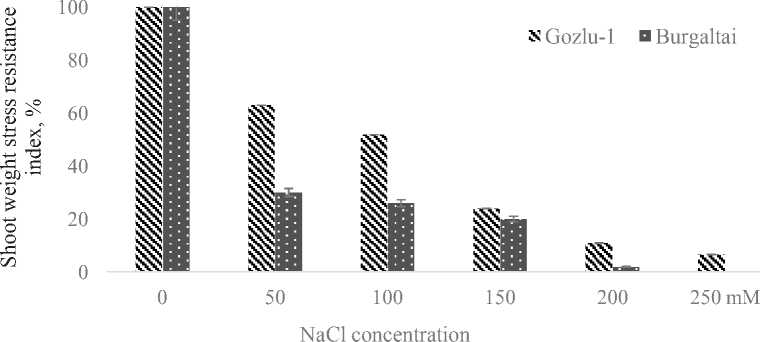
Fig. 5. Shoot weight index of alfalfa varieties treated with different concentrations of salt, %. Columns indicate the mean and error; bars indicate the standard deviation of three replications
Root weight
The root weight index of the Burgaltai variety stressed by watering with different salt concentrations decreased by 0.09 g (57.0 %) at 50 mM, 0.11 g (69.0 %) at 100 mM, 0.118 g (74.0 %) at 150 mM, and 0.15 g (95.0 %) at 200 mM compared to the control plants, and root growth stopped completely at 250 mM (Fig. 6). The root weight index of the Gozlu-1 variety decreased by 0.05 g (32.1 %) at 50 mM, 0.07 g (44.2 %) at 100 mM, 0.11 g (66.0 %) at 150 mM, 0.13 g (82.0 %) at 200 mM, and 0.15 g (91.4 %) at 250 mM compared to control plants (Fig. 6). According to these results, the root weight of the Gozlu-1 variety was 24.9 % higher than the Burgaltai variety at 50 mM, 24.8 % at 100 mM, 8.0 % at 150 mM, 13.0 % at 200 mM, and 9.6 % at 250 mM.
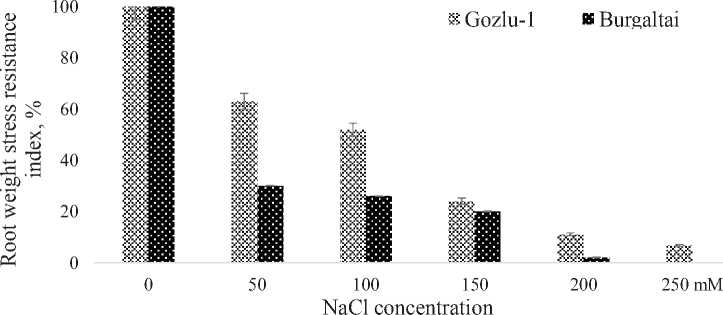
Fig. 6. Root weight index of alfalfa varieties treated with different salt concentrations, %. Columns indicate the mean and error; bars indicate the standard deviation of three replications.
Effect of salt on the stress resistance index of leaf dry weight
The stress resistance index of leaf dry weight of the salt-stressed plants decreased with increasing salt concentrations. Compared to control plants, the stress resistance index of leaf dry weight of the Burgaltai variety decreased by 58.3 % at 50 mM, 59.5 % at 100 mM, 92.1 % at 150 mM, 96.9 % at 200 mM, and 99.5 % at 250 mM. The stress resistance index of Gozlu-1 leaf dry weight decreased by 48.9% at 50 mM, 80.5 % at 100 mM, 81.9 % at 150 mM, 87.7 % at 200 mM, and 94.9 % at 250 mM (Fig. 7). The Gozlu-1 leaf dry weight stress tolerance index was 9.3 % higher than the Burgaltai variety at 50 mM, 10.1% at 150 mM, 9.2 % at 200 mM, and 4.6 % at 250 mM. The results showed that the alfalfa leaf dry weight stress tolerance index decreased by 48–58 % at 50 mM and 94–99 % at 250 mM (Fig. 7).
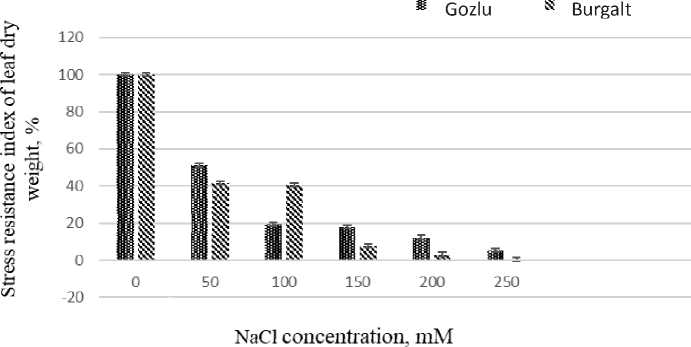
Fig. 7. Dry weight index of alfalfa leaves. Columns indicate the mean and error; bars indicate the standard deviation of three replications
Effect of salt on total chlorophyll content
The chlorophyll content of Gozlu-1 and Burgaltai leaves stressed by salt under laboratory conditions was measured by spectrophotometry.
The chlorophyll content of Gozlu-1 not exposed to salt stress (control plants) was higher than that of Burgaltai. When measuring the chlorophyll content of the Burgaltai variety exposed to salt stress, the content decreased by 2.6 mg/ml at 50 mM, 3.4 mg/ ml at 100 mM, 4.9 mg/ml at 150 mM, 6.4 mg/ml at 200 mM, and 7.3 mg/ml at 250 mM compared to control plants. The chlorophyll content of the Gozlu-1 variety exposed to salt stress decreased by 6.5 mg/ml at 50 mM, 6.7 mg/ml at 100 mM, 7.0 mg/ml at 150 mM, 9.5 mg/ml at 200 mM, and 11.3 mg/ml at 250 mM (Figure 8).The amount of chlorophyll in the salt-stressed Gozlu-1 variety was 60.0 % higher than the Burgaltai variety at 50 mM, 49.3 % at 100 mM, 30.0 % at 150 mM, 32.6 % at 200 mM, and 35.3 % at 250 mM (Fig. 8).

Fig. 8. Leaf chlorophyll content of alfalfa varieties exposed to salt stress.
Columns indicate the mean and error; bars indicate the standard deviation of three replications
The leaf water absorption intensity of alfalfa varieties treated with different salt solutions (ranging from 0 to 250 mM) decreased gradually with increasing salt concentration compared to the control plants (Fig. 9).
The water absorption capacity of Burgaltai seeds completely stopped when treated with a NaCl concentration of 200 mM or more.
When treated with a concentrated salt solution of 50 mM, the water absorption intensity of Burgaltai leaves decreased by 56.5 % at 50 mM, 62.3 % at 100 mM, 64.2 % at 150 mM, 71.8 % at 200 mMcompared to the control, and completely stopped at 250 mM.
The water absorption intensity of Gozlu-1 leaves decreased by 16.7% at 50 mM, 37.1 % at 100 mM, 40.7 % at 150 mM, 57.2 % at 200 mM, and 78.6 % at 250 mM compared to the control.
The water absorption intensity of Gozlu-1 leaves was 39.8 % higher than the Burgaltai variety at 50 mM, 25.2 % at 100 mM, and 23.5 % at 150 mM, 14.6 % at 200 mM, respectively.
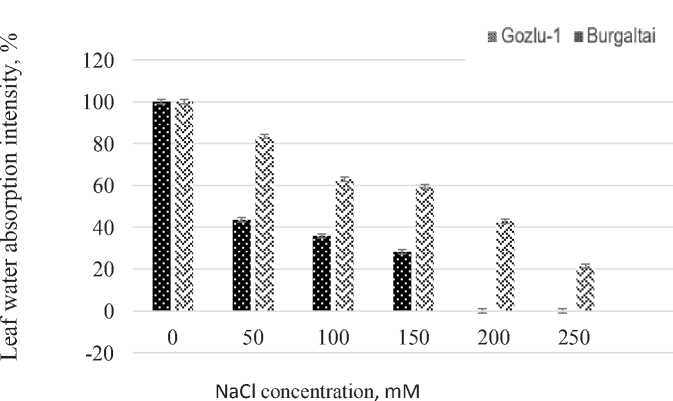
Fig. 9. Leaf water absorption intensity of alfalfa varieties subjected to salt stress by various salt concentrations. Columns indicate the mean and error; bars indicate the standard deviation of three replications
Discussion
Alfalfa is a good fodder plant with a rich ratio of protein and essential amino acids, carbohydrates, mineral salts, and other substances [Batsukh, Tsogoo, 2021]. The study of the salinity tolerance of Medicago varia Martyn and the Gozlu-1 variety was determined by morphological and physiological measurements in laboratory conditions.
Alfalfa has been cultivated for more than 3 000 years [Erdenejav, 2015]. Plants vary in their sensitivity to salt; some plants are resistant to salt, while others die immediately. In the process of evolution, some plant species have become able to adapt to high salinity conditions, while most of them grow in salt-free conditions and are sensitive to salt [Tsendeekhuu, 2018]. Salinity causes salt stress in plants, reducing seed germination and leaf water content and increasing chloride ion concentration and lipid peroxidation.
The Uuganzaya (2017) study showed that alfalfa ( M. sativa L.) grown in Russia stressed by irrigation with different salt concentrations (0, 50, 100, 150, and 200 mM) for 14 days was found to be resistant to salinity in terms of morphology and physiology.
In a salinity experiment [Castroluna et al., 2014], cultivated alfalfa ( M. sativa L.) was stressed for a week with 0, 50, 100, 150, and 200 mM salt solutions. The alfalfa ( M. sativa L.) cultivated showed 7 % germination at the highest concentration of 200 mM and 54 % at 100 mM. According to Adiyasuren (2017), the germination intensity was 0 % at 200 mM and 67.6 % at 100 mM. It can be concluded from the results of this study that Gozlu-1 alfalfa variety grows poorly in soils with high concentrations of salt.
Researchers measured the salt tolerance of cultivated alfalfa ( M. sativa L.) at the highest salt concentration of 250 mM by morphological parameters; as the salt concentration increased, the plant root length decreased by 68.9 % compared to the control version [Guo et al., 2016]. In the study by Adiyasuren (2017), it was determined that the root length of M. sativa L. exposed to salt solution stress at 200 mM was 70.0 % less than the control version. In our study, the root length of Gozlu-1 was 53.8 % at 200 mM and 70 % less at 250 mM compared to the control.
A study by Kanawapee et al. (2012) found that the activity of leaf apical cells of plants subjected to salt stress decreases water loss and slows down the growth and development of plants. Chlorine ions enter the leaves through the apoplast system, inhibiting photosynthesis and chlorophyll synthesis [Jansaya, 2019]. When plants are subjected to salt stress, their photosynthetic process is reduced [Tsendeekhuu, 2018].
According to the results of our research, as the concentration of salt solutions increased, the total chlorophyll content of alfalfa leaves decreased, and the leaves turned yellow. This was due to the change in nitrogen exchange due to the excess salt accumulated, the accumulation of toxic substances in cells and tissues, damage to the delicate structure of plant cells, and damage to chloroplasts.
In the study by Uuganzaya (2017), when watered for 14 days with solutions with different salt concentrations (0, 50, 100, 150, and 200 mM), the chlorophyll content of cultivated alfalfa ( M. sativa L.) increased by 16.1–23.7 % compared to the control, but it decreased by 10.4–42.7 % in the Burgaltai variety. According to our research, the chlorophyll content of Gozlu-1 decreased by 15.1–70.5 % compared to the control and by 26.0–75.2 % compared to the Burgaltai variety.
Carillo et al. (2011) found that the toxic effect of Cl anion can cause chlorophyll deficiency and the yellowing of leaves. Salt stress inhibits soil water uptake [Munns, 2005]. As a result, the growth and development of the plant begin to slow down. Salt accumulation in plant apoplasts slows down plant growth [Tsendeekhuu, 2018]. As a result, plant cells and tissues begin to dehydrate. Therefore, it is believed that the morphological and physiological parameters of alfalfa taken in the study are decreasing.
Conclusion
-
1. When the seed germination intensity of salt tolerance of alfalfa cultivars was observed in vitro , the seed germination stress tolerance index of the Gozlu-1 variety was 11.2–39.0 % more resistant than that of the Burgaltai variety.
-
2. According to the results of chlorophyll content in alfalfa leaves exposed to salt stress, as the concentration of salt increased, the amount of chlorophyll decreased, and morphological changes such as the drying and shriveling of leaves, loss of green mass, and thinning of roots occurred more strongly compared to control plants.
-
3. The Gozlu-1 variety was more salt-resistant than the Burgaltai variety in terms of morphological and physiological parameters, so it is considered suitable for cultivation under irrigated and saline soil conditions.
Список литературы Comparition of salt tolerance of turkish alfalfa (Medicago sativa L. var. Gozlu-1)
- Adiyasuren M. Alfalfa Drought and Salt Tolerance is Determined by Some Morphological and Physiological Parameters. 2017, pp. 19–25.
- Batchuluun Ts., Gerelbaatar S. Soil Science. Ulaanbaatar, 2015, pp. 24–25.
- Batsukh Sh., Tsogoo D. Alfalfa. Ulaanbaatar, 2021, pp. 23–33.
- Carillo P., Annunziata M. G., Pontecorvo G. et al. Salinity Stress and Salt Tolerance. In: A. K. Shanker, B. Venkateswarlu (eds.). Abiotic Stress in Plants – Mechanisms and Adaptations. Rijeka, InTech, 2011: 32–36.
- Castroluna A., Ruiz O. M., Quiroga A. M., Pedranzani H. E. Effects of Salinity and Drought Stress on Germination, Biomass and Growth in Three Varieties of Medicago sativa L. Avences en Investigation Agropecuaria. 2014; 18(1): 39–50.
- Erdenejav G. Alfalfa. Ulaanbaatar, 2015, pp. 45–56.
- Jansaya Y., Enkhchimeg V. Comparison of Drought and Salt Stress Tolerance of Alfalfa Varieties by Some Morphological and Physiological Parameters. 2019, pp. 25–39.
- Kanawapee N., Sanitchon J., Lontom W., Threerakulpisut P. Evaluation of Salt Tolerance at the Seedling Stage in Rice Genotypes by Growth Performance, Ion Accumulation, Proline and Chlorophyll Content. Plant Soil. 2012; 358: 235–249.
- Swiss Agency for Development and Cooperation. Mongolian National Pasturel and Status Report. Available at: https://www.eda.admin.ch/dam/countries/countries-content/mongolia/en/ Mongolia-Rangeland-Health-Report_MN.pdf (accessed 20.11.2022).
- Munns R. Genes and Salt tolerance: Bringing them Together. New Phytologist. 2005; 167: 645–663. https://doi.org/10.1111/j.1469-8137.2005.01487.x
- Murillo-Amador B., Lopez-Aguilar R., Kaya C. et al. Comparative Effects of NaCl and Polyethylene Glycol on Germination, Emergence and Seedling Growth of Cowpea. J. Agron. Crop. Sci. 2002; 188: 235–247.
- Ministry of Food, Agriculture and Light Industry. Available at: http://www.msrm.mn/index.php?option=com_content&view=category&layout=blog&id=83&Itemid=468&limitstart=5 (accessed 14.10.2022).
- Sammar Raza M. A., Saleem M. F., Ashraf M. Y. Glycinebetaine Applied under Drought Improved the Physiological Efficiency of Wheat (Triticum aestivum L.) plant. Soil Environment. 2021; 31(1): 67–71.
- Tsendeekhuu Ts. Physiology of Plants. Ulaanbaatar, 2018, pp. 373–375.
- Uuganzaya M. Transplantation of Arabidopsis Thaliana-Growth Activator AtGRF2 (Arabidopsis thaliana growth regularing factor) Gene into Alfalfa Genome. 2017, pp. 39–64.
- Peng Guo, Hong Xu Wei, Wanjun Zhang, Yajing Bao. Physiological Responces of Alfalfa Ion Flux and Stomatal Characteristics. Int. J. Agric Biol. 2016; 18: 125.

